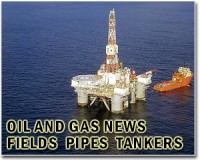 |
Washington (AFP) May 7, 2010 Survivors of the huge oil rig blast in the Gulf of Mexico say alarms designed to warn them of an imminent explosion never sounded, ABC News reported Friday. Oil industry experts meanwhile acknowledged that critical safety equipment failed to prevent the explosion and subsequent oil spill, one of the worst in US history. "It was chaos," survivor Dwayne Martinez told ABC News. "Nothing went as planned, like it was supposed to." Survivors described terrifying scenes during the chain reaction that left 11 workers dead on the Deepwater Horizon offshore drilling platform. After a first concussion rocked the rig on April 20, a huge plume of gas vapor belched from the well and encircled the platform. The gas cloud then ignited during a second, larger burst, they said. "It was people screaming and hollerin'," said Micah Sandell, another survivor. "I never seen nothing like that. Never." Rig workers had begun injecting seawater into the well to replace a plug of mud preventing the gas and oil from being pumped. A valve on a blowout preventer -- a huge 50-foot (15-meter), 900,000-pound (408-tonne) safety device that sits on the seabed a mile (1.6 kilometers) below the surface -- that should have been closed was open, according to Tulane Energy Institute associate director Eric Smith. The change in pressure would have launched the seawater and mud, followed by the gas through the well pipe up toward the surface. Water and mud rose 300 feet (91 meters) into the air, according to Martinez and Sandell. "As the bubble made its way to us, it would get bigger and bigger and accelerate rapidly," Smith said. "First thing that would happen would be a water spout. It would have been raining salt water." Transocean Ltd, which owns the rig that was leased to energy giant BP, declined to speculate on whether the alarms sounded and why they may not have sounded. The incident shows that "the alarms failed or that somebody muted the alarm because alarms are so common out in the oil patch that sometimes as a matter of course, they mute alarms," said Tony Buzbee, a lawyer representing the two oil rig workers in a lawsuit against both companies. The oil industry has long relied on blowout preventers, which house hydraulic valves designed to cap any oil or gas leaks, as part of its fail-safe mechanisms. But ABC News said it had obtained documents showing the industry has long known of problems with the device, also know as a BOP. "Poor BOP reliability is a common and very costly issue confronting all offshore drilling contractors," it quoted a Transocean official as saying during an industry conference in 2003. Sandell was outraged by the safety failures that nearly claimed his life. "They always tell us that we have safety devices and warnings and they got ways of shutting it in," he said." And it don't seem like they had nothing."
Share This Article With Planet Earth
Related Links Powering The World in the 21st Century at Energy-Daily.com
 Falklands oil company reports first find
Falklands oil company reports first findStanley, Falkland Islands (UPI) May 6, 2010 After disappointing results earlier in the year that caused dismay and panic among investors, the Falklands' first oil discovery was reported Thursday by the company prospecting in the British-ruled archipelago's northern basin. Rockhopper Exploration said exploration of well 14/10-2 on the Sea Lion prospect in the North Falkland Basin had produced promising results after it reached a d ... read more |
|
| The content herein, unless otherwise known to be public domain, are Copyright 1995-2010 - SpaceDaily. AFP and UPI Wire Stories are copyright Agence France-Presse and United Press International. ESA Portal Reports are copyright European Space Agency. All NASA sourced material is public domain. Additional copyrights may apply in whole or part to other bona fide parties. Advertising does not imply endorsement,agreement or approval of any opinions, statements or information provided by SpaceDaily on any Web page published or hosted by SpaceDaily. Privacy Statement |